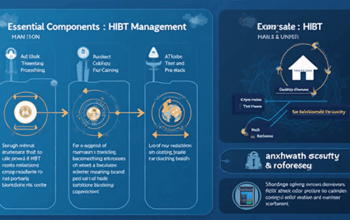Bitcoin DeFi Flash Loan Attacks: Understanding the Vulnerabilities
With over $4.1B lost to DeFi hacks in 2024 alone, the need for robust security in decentralized finance has never been clearer. As the DeFi landscape continues to grow, understanding threats like flash loan attacks becomes crucial for participants.
What Are Flash Loans?
Flash loans, a popular feature in DeFi, enable users to borrow assets without collateral for a extremely short period. These loans must be repaid within the same transaction. Here’s a simple analogy: think of it as borrowing a book from a library, but you need to return it before you step out the door.
The Mechanics of Flash Loans
- Instantaneous transactions
- No need for collateral
- High risk of exploitation
Common Vulnerabilities in Flash Loans
Flash loans, while revolutionary, expose several vulnerabilities that can be exploited by malicious actors. Understanding these vulnerabilities is essential for anyone operating in the DeFi space.

1. Price Manipulation
Attackers can manipulate token prices through coordinated flash loans, creating a temporary price inflation or deflation. Imagine a scenario where someone borrows a significant amount of an asset, selling it just after the price spikes due to the sudden influx.
2. Smart Contract Exploits
Flaws in smart contracts can also be a gateway for attacks. For example, exploiting a reentrancy attack, which allows an attacker to make recursive calls to drain funds. This situation highlights the necessity of proper smart contract audits.
3. Oracle Manipulation
Oracles, which provide external data to smart contracts, can be manipulated. If the data is altered, it can lead to unwanted price behaviors and exploited opportunities. Hence, ensuring the reliability of oracles is vital, akin to having a trustworthy weather reporter before planning your travel.
Real-World Examples of Flash Loan Attacks
Flash loan attacks are not just theoretical; they have led to significant losses in recent times. Here are a couple of examples to illustrate:
Example 1: bZx Attacks
One of the most notorious incidents took place in February 2020 when the bZx protocol was exploited via a flash loan that manipulated the price of Wrapped Ether (WETH) and resulted in approximately $1M lost.
Example 2: Harvest Finance Incident
In October 2020, Harvest Finance suffered losses of around $33M due to a flash loan exploit. Attackers manipulated the price of stablecoins to profit from the system.
Mitigating Risks Associated with Flash Loans
While risks are inherent in any financial system, implementing precautionary measures can greatly mitigate exposure. Here are some strategies:
1. Robust Smart Contract Audits
Frequent audits of smart contracts can help prevent exploitable vulnerabilities. Professional firms should conduct thorough checks, ensuring your project is secure.
2. Use of Multi-Signature Wallets
Implementing multi-signature wallets can enhance security, requiring multiple authorizations for transactions, thus reducing risk.
3. Employing Price Oracles with Higher Security Standards
Using oracles with a proven track record can reduce vulnerability to manipulation. Trusted data sources are essential for accurate real-time information.
4. Community Engagement and Education
As DeFi continues to evolve, educating the community about potential risks and fraudulent tactics remains crucial. Whether through webinars, community forums, or social media, building awareness is key.
The Impact of Flash Loan Attacks on the DeFi Ecosystem
Flash loan attacks significantly impact DeFi participants, shaking their trust. Following these exploits, protocols must adapt and evolve. Below are some consequences:
1. Decreased User Trust
Each attack diminishes user confidence in DeFi protocols, creating hesitations in future investments. Users may begin to question the very foundation of decentralized finance.
2. Regulatory Scrutiny
As incidents garner mainstream headlines, regulators become more involved, with potential increased regulations shaping how DeFi operates. Compliance will play a larger role.
Future of Flash Loans in DeFi
While flash loans face scrutiny, they are not going away. Rather, their function will evolve. The community will see intensified discussions about security practices and improved technologies to safeguard user assets.
1. Innovative Security Protocols
The rise of new security protocols, like liquidation bots that rely on data aggregators, might prevent future disruptions. These can react quickly to potential vulnerabilities.
2. Introduction of Flash Loan Governance
Governance tokens could emerge to control flash loan parameters, allowing community members to influence decision-making in a project, ensuring collective interest.
3. Growth in Popularity of Safe Assets
Users may gravitate towards safer assets when engaging with flash loans, preferring protocols with proven security measures. This aligns with a growing demand for decentralization and security.
Conclusion
In conclusion, understanding Bitcoin DeFi flash loan attacks is essential as they become more prevalent in the digital finance space. By chronicling their vulnerabilities and scrutinizing their implications, individuals and projects can enhance their defensive tactics effectively.
Investors, developers, and users are encouraged to collaborate on monitoring changes in protocols. In a world increasingly dependent on tiêu chuẩn an ninh blockchain, staying vigilant and informed is the best practice.
At the end of the day, as DeFi matures, understanding and securing against flash loan attacks will play a critical role in ensuring the integrity of protocols.
For those interested in securing their digital assets further, platforms like Btctokenio provide an excellent resource on the current landscape of DeFi security. Remember, knowledge is your best asset in navigating the world of cryptocurrencies.
Dr. Alex Nguyen, a leading blockchain security researcher, has published over 20 articles in the field and led audits on various prestigious protocols.





